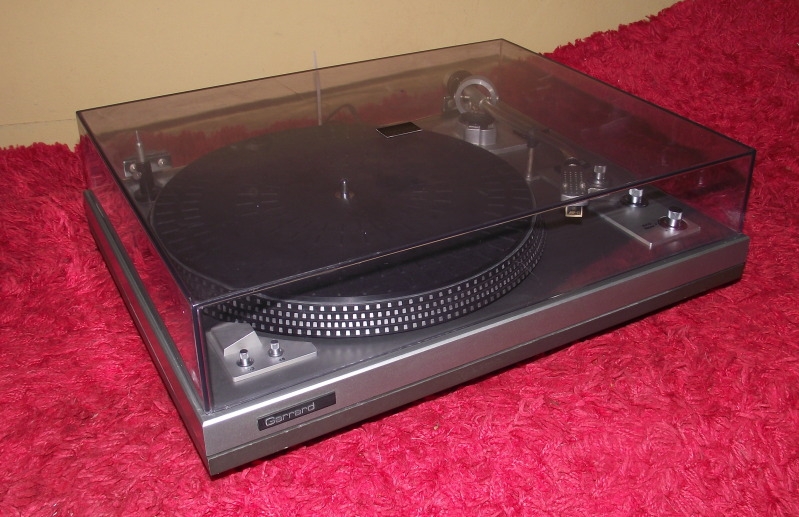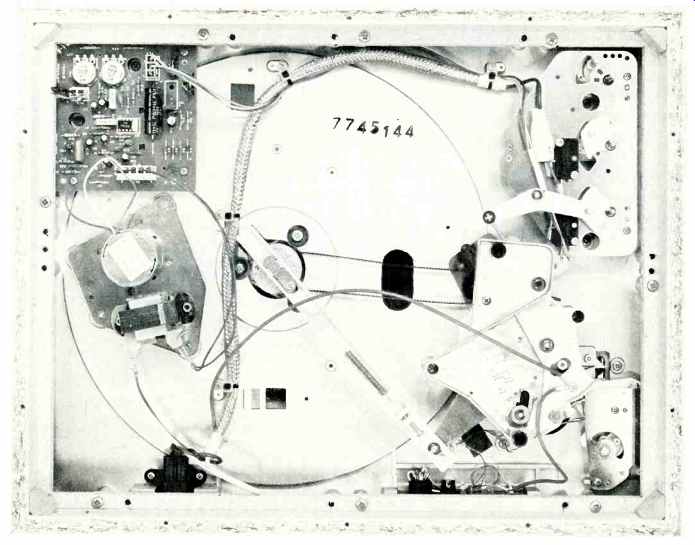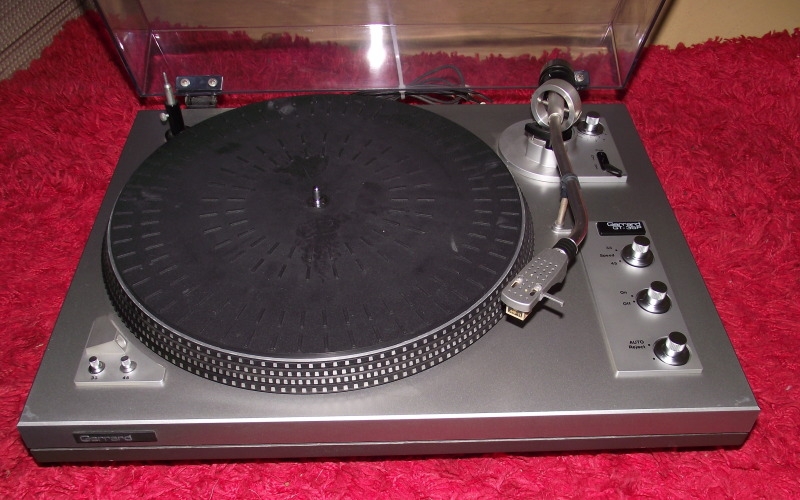Garrard Model GT-35 Automatic Turntable


MANUFACTURER'S SPECIFICATIONS
Speeds: 33 and 45 rpm.
Motor: D.C. servo controlled.
Number of Records in Auto Mode: 5.
Wow & Flutter: 0.05 percent.
Rumble: -68 dB (DIN B).
Dimensions: 18 in. (45.7 cm) W x 14/ in. (36.8 cm) D x 7 1/2 in. (19 cm) H.
Weight: 15 1/2 lbs. (7 kg).
Price: $219.95.
The Garrard GT-35 is next to the top-of-the-line automatic turntable from this old, established company and, as you might expect, it incorporates. many of the innovations used on the GT-55, first of the "Generation Two" series. These features include the Delglide mechanical system with its self-lubricating properties and the new d.c. servo belt-drive motor. The GT-55 has a straight magnesium arm and offset tangential-tracking, articulating headshell, while the newer GT-35 has an aluminum S-shaped arm with a magnesium head shell. The weight of the arm is lower; 12 grams for the GT-35 as compared to 14 grams for the GT-55. Jeweled bearings are used in the vertical pivot and ball bearings in the horizontal pivot.

An uncomplicated platform-type record stacking system is employed, taking a total of five records. There are two alternative center spindles, one for multiple play and one for single play, supplied with the unit. On the right hand side are three rotary controls: The first one is for either Start or Reject, while the second control has four positions, Off, Manual, Automatic, and Repeat. The third control selects the speeds, either 33 or 45 rpm. At the rear is a Cue lever and an Anti Skating dial, both of which are mounted on the tonearm base.
On the left-hand side, at the front, are two small speed controls together with an LED strobe light that shines on bars cut into the rim of the platter, which is made of diecast aluminum and tips the scales at 3/ lbs. (1.59 kg). The Delglide system which controls the tonearm movement is driven by a separate belt ... a method claimed to give a smoother overall operation than conventional single-belt arrangements.
In appearance, the turntable bears a closer resemblance to the current U.S. and Japanese designs, rather than European designs, with an attractive black and silver finish making a pleasing contrast to the rosewood veneered base. The unit comes complete with a transparent dustcover and a separate power supply lead which plugs into a socket at the rear.
Phono terminations are taken to a pair of RCA-type sockets, also at the rear.
Measurements
For test purposes a Shure V-15 MK III was used, although an Audio Technica AT-13e was also checked rater. An alignment gauge is supplied with the turntable, and even the clumsiest should have no difficulty using it in mounting a cartridge. The tonearm was set up by the usual static balance method, while the tracking force and Anti-Skating dial were both adjusted for 1.8 grams. The first test was for wow and flutter and the combined figures came out to a hair over 0.04 percent. Rumble measured-61.5 dB using the ARLL weighting method, which roughly corresponds to-71 dB with the DIN B rating method, and this means that the unit was some 3 dB better than the 68 dB DIN specified. The speed control range was -4.5 to +5 percent, and the speed remains constant and is not affected by reasonable power supply variations. The stylus force and anti-skating calibrations were found to be very accurate . .. certainly within 5 percent above one gram. I ought to mention that there are two scales on the Anti-Skating dial, one for conical styli and the other for elliptical and CD-4 styli. Tonearm resonance measured 9 Hz with the Shure V-15 Mk III cartridge, a safe frequency, and arm friction was too low to measure accurately, although it was confirmed that the lateral friction was somewhat greater than the vertical. Tracking error was, as might be expected, less than 5 degrees per inch which is typical of this kind of arm configuration.
Turning to the automatic function, the changing cycle was faster than usual, taking only seven seconds to complete the cycle. I was pleased to see that the tonearm was handled very nicely and gently; in fact I doubt that many people could move the tonearm as carefully. The cue lever appeared to be well damped and free from annoying side play.
Listening and Use Tests
Record changers have come a long way since those "built like a battleship" models which were enormously complicated mechanical marvels appearing on the market almost 40 years ago. Modern units, like the GT-35, perform the same functions with a minimum of parts, noise, or fuss, and they do this while offering such advantages as servo-speed control, precisely-made tonearms which can track at less than one gram, and provision for single-play manual operation.
The workmanship on the GT-35 is excellent and the unit comes with a three-year warranty. The simple, straightforward mechanism with Delglide should give years of trouble free service. Are there any criticisms? Yes, there are two small criticisms; it is difficult to see the indicator markings on the control knobs and, probably more important, I would like to see less side-play on the tonearm base.
-George W. Tillett
(Audio magazine, Apr. 1978 )
Also see:
Garrard Synchro-Lab 95B turntable (Mar. 1970)
ELAC/Miracord 760 Automatic Turntable (Aug. 1975)
= = = =